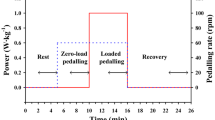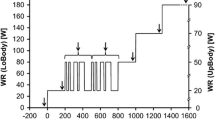Abstract
During non-steady-state exercise, dynamic changes in pulmonary oxygen uptake (\(\dot{V} {\text{O}_{\text{2pulm}}}\)) are dissociated from skeletal muscle \( \dot{V} {\text{O}_2}\) (\(\dot{V} {\text{O}_{\text{2musc}}}\)) by changes in lung and venous O2 concentrations (CvO2), and the dynamics and distribution of cardiac output (CO) between active muscle and remaining tissues (\( \dot{Q}_{\text{rem}}\)). Algorithms can compensate for fluctuations in lung O2 stores, but the influences of CO and CvO2 kinetics complicate estimation of \(\dot{V} {\text{O}_{\text{2musc}}}\) from cardio-pulmonary measurements. We developed an algorithm to estimate \(\dot{V} {\text{O}_{\text{2musc}}}\) kinetics from \(\dot{V} {\text{O}_{\text{2pulm}}}\) and heart rate (HR) during exercise. 17 healthy volunteers (28 ± 7 years; 71 ± 12 kg; 7 females) performed incremental exercise using recumbent cycle ergometry (\(\dot{V} {\text{O}_{\text{2peak}}}\) 52 ± 8 ml min−1 kg−1). Participants completed a pseudo-random binary sequence (PRBS) test between 30 and 80 W. \(\dot{V} {\text{O}_{\text{2pulm}}}\) and HR were measured, and CO was estimated from HR changes and steady-state stroke volume. \(\dot{V} {\text{O}_{\text{2musc}}}\) was derived from a circulatory model and time series analyses, by solving for the unique combination of venous volume and the perfusion of non-exercising tissues that provided close to mono-exponential \(\dot{V} {\text{O}_{\text{2musc}}}\) kinetics. Independent simulations showed that this approach recovered the \(\dot{V} {\text{O}_{\text{2musc}}}\) time constant (τ) to within 7 % (R 2 = 0.976). Estimates during PRBS were venous volume 2.96 ± 0.54 L; \( \dot{Q}_{\text{rem}}\) 3.63 ± 1.61 L min−1; τHR 27 ± 11 s; τ\(\dot{V} {\text{O}_{\text{2musc}}}\) 33 ± 8 s; τ\(\dot{V} {\text{O}_{\text{2pulm}}}\) 43 ± 14 s; \(\dot{V} {\text{O}_{\text{2pulm}}}\) time delay 19 ± 8 s. The combination of stochastic test signals, time series analyses, and a circulatory model permitted non-invasive estimates of \(\dot{V} {\text{O}_{\text{2musc}}}\) kinetics. Large kinetic dissociations exist between muscular and pulmonary \(\dot{V} {\text{O}_{\text{2}}}\) during rapid exercise transients.






Similar content being viewed by others
Abbreviations
- ACF:
-
Auto-correlation function
- ACFoffset :
-
Shift of the auto-correlation function baseline
- CaO2 :
-
Arterial oxygen concentration
- CCF:
-
Cross-correlation function
- CCFmax :
-
Peak of cross-correlation function
- CO:
-
Cardiac output
- CvmuscO2 :
-
Venous oxygen concentration in exercising muscle
- CvremO2 :
-
Oxygen concentration in venous from non-exercising tissues
- HR:
-
Heart rate
- PRBS:
-
Pseudo-random binary sequence
- \( \dot{Q}_{\text{rem}}\) :
-
Perfusion of non-exercising tissues
- \( \dot{Q}_{\text{musc}}\) :
-
Perfusion of exercising muscle
- SV:
-
Stroke volume
- τ:
-
Time constant of mono-exponential function
- TD:
-
Time delay of mono-exponential function
- t max :
-
Time (relative to exercise onset) of CCFmax
- \(\dot{V} {\text{O}_{\text{2musc}}}\) :
-
Exercising muscle oxygen uptake
- \(\dot{V} {\text{O}_{\text{2pulm}}}\) :
-
Pulmonary oxygen uptake
- \(\dot{V} {\text{O}_{\text{2rem}}}\) :
-
Oxygen uptake in non-exercising tissues
- V v :
-
Venous volume
- WR:
-
Work rate
References
Aliverti A, Kayser B, Cautero M, Dellacà RL, Di Prampero PE, Capelli C (2009) Pulmonary V′O2 kinetics at the onset of exercise is faster when actual changes in alveolar O2 stores are considered. Respir Physiol Neurobiol 169:78–82
Åstrand I, Åstrand PO, Christensen E, Hedeman R (1960) Intermittent muscular work. Acta Physiol Scand 48:448–453
Bangsbo J, Krustrup P, Gonzalez-Alonso J, Boushel R, Saltin B (2000) Muscle oxygen kinetics at onset of intense dynamic exercise in humans. Am J Physiol Regul Integr Comp Physiol 279:R899–R906
Barstow TJ, Lamarra N, Whipp BJ (1990) Modulation of muscle and pulmonary O2 uptakes by circulatory dynamics during exercise. J Appl Physiol 68:979–989
Beaver WL, Lamarra N, Wasserman K (1981) Breath-by-breath measurement of true alveolar gas exchange. J Appl Physiol 51:1662–1675
Behnke BJ, Barstow TJ, Poole DC (2005) Relationship between VO2 responses at the mouth and across the exercising muscles. In: Jones AM, Poole DC (eds) Oxygen uptake kinetics in sport, exercise and medicine. Routledge, New York, pp 141–153
Bowen TS, Murgatroyd SR, Cannon DT, Cuff TJ, Lainey AF, Marjerrison AD, Spencer MD, Benson AP, Paterson DH, Kowalchuk JM, Rossiter HB (2011) A raised metabolic rate slows pulmonary O2 uptake kinetics on transition to moderate-intensity exercise in humans independently of work rate. Exp Physiol 96:1049–1061
Casaburi R, Whipp BJ, Wasserman K, Beaver WL, Koyal SN (1977) Ventilatory and gas exchange dynamics in response to sinusoidal work. J Appl Physiol 42:300–301
Cautero M, Di Prampero PE, Capelli C (2003) New acquisitions in the assessment of breath-by-breath alveolar gas transfer in humans. Eur J Appl Physiol 90:231–241
di Prampero PE, Davies CT, Cerretelli P, Margaria R (1970) An analysis of O2 debt contracted in submaximal exercise. J Appl Physiol 29:547–551
Edwards A, Claxton D, Fysh M (2003) A comparison of two time-domain analysis procedures in the determination of V′O2 kinetics by pseudorandom binary sequence exercise testing. Eur J Appl Physiol 88:411–416
Essfeld D, Hoffmann U, Stegemann J (1987) V’O2 kinetics in subjects differing in aerobic capacity: investigation by spectral analysis. Eur J Appl Physiol 56:508–515
Essfeld D, Hoffmann U, Stegemann J (1991) A model for studying in the distortion of muscle oxygen uptake patterns by circulation parameters. Eur J Appl Physiol 62:83–90
Fortin J, Habenbacher W, Heller A, Hacker A, Grüllenberger R, Innerhofer J, Passath H, Wagner Ch, Haitchi G, Flotzinger D, Pacher R, Wach P (2006) Non-invasive beat-to-beat cardiac output monitoring by an improved method of transthoracic bioimpedance measurement. Comput Biol Med 36:1185–1203
Gordon D, Marshall K, Connell A, Barnes RJ (2010) Influence of blood donation on oxygen uptake kinetics during moderate and heavy intensity cycle exercise. Int J Sports Med 31:298–303
Grassi B, Poole DC, Richardson RS, Knight DR, Erickson BK, Wagner P (1996) Muscle O2 uptake kinetics in humans: implications for metabolic control. J Appl Physiol 80:988–998
Hughson RL, Winter DA, Patla AE, Swanson GD, Cuervo AE (1990) Investigation of V′O2 kinetics in humans with pseudorandom binary sequence work rate change. J Appl Physiol 68:796–801
Inman MD, Hughson RL, Weisiger KH, Swanson GD (1987) Estimate of mean tissue O2 consumption at onset of exercise in males. J Appl Physiol 63:1578–1585
Koga S, Poole DC, Shiojiri T, Kondo N, Fukuba Y, Miura A, Barstow TJ (2005) Comparison of oxygen uptake kinetics during knee extension and cycle exercise. Am J Physiol Regul Integr Comp Physiol 288:R212–R220
Krustrup P, Jones AM, Wilkerson DP, Calbet JAL, Bangsbo J (2009) Muscular and pulmonary O2 uptake kinetics during moderate- and high-intensity sub-maximal knee-extensor exercise in humans. J Physiol 587:1843–1856
Lamarra N, Whipp BJ, Ward SA, Wasserman K (1987) Effect of interbreath fluctuations on characterizing exercise gas exchange kinetics. J Appl Physiol 62:2003–2012
MacDonald MJ, Tarnopolsky MA, Hughson RL (2000) Effect of hyperoxia and hypoxia on leg blood flow and pulmonary and leg oxygen uptake at the onset of kicking exercise. Can J Physiol Pharmacol 78:67–74
Meyer RA (1988) A linear model of muscle respiration explains monoexponential phosphocreatine changes. Am J Physiol 254:C548–C553
Poole DC, Gaesser GA, Hogan MC, Knight DR, Wagner PD (1992) Pulmonary and leg V′O2 during submaximal exercise: implications for muscular efficiency. J Appl Physiol 72:805–810
Rossiter HB (2011) Exercise: kinetic considerations for gas exchange. Comp Physiol 1:203–244
Rossiter HB, Ward SA, Doyle VL, Howe FA, Griffiths JR, Whipp BJ (1999) Inferences from pulmonary O2 uptake with respect to intramuscular [phosphocreatine] kinetics during moderate exercise in humans. J Physiol 518:921–932
Turner AP, Cathcart AJ, Parker ME, Butterworth C, Wilson J, Ward SA (2006) Oxygen uptake and muscle desaturation kinetics during intermittent cycling. Med Sci Sports Exerc 38:492–503
Whipp BJ, Ward SA, Lamarra N, Davis JA, Wasserman K (1982) Parameters of ventilatory and gas exchange dynamics during exercise. J Appl Physiol 52:1506–1513
Acknowledgments
The study was supported by: the DLR (Deutsches Zentrum für Luft- und Raumfahrt), Germany (FKZ 50WB0726); and the Biotechnology and Biological Sciences Research Council, UK (BB/I00162/X).
Conflict of interest
The authors declare that they have no conflict of interest.
Author information
Authors and Affiliations
Corresponding author
Additional information
Communicated by Keith Phillip George.
Rights and permissions
About this article
Cite this article
Hoffmann, U., Drescher, U., Benson, A.P. et al. Skeletal muscle \( \dot{V} {\text{O}_2}\) kinetics from cardio-pulmonary measurements: assessing distortions through O2 transport by means of stochastic work-rate signals and circulatory modelling. Eur J Appl Physiol 113, 1745–1754 (2013). https://doi.org/10.1007/s00421-013-2598-7
Received:
Accepted:
Published:
Issue Date:
DOI: https://doi.org/10.1007/s00421-013-2598-7




